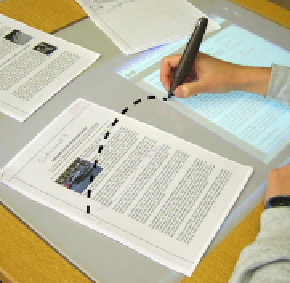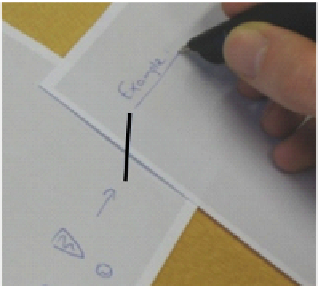Information Technology Reference
In-Depth Information
(a) Single line gesture
(b) Two-part gesture
+
+
+
Fig. 6.4
Pen gestures for creating a hyperlink. The lower part indicates which core interactions are
combined
references (e.g. “see p. 4”, “cf. Wikipedia Digital Paper”), which indicate the link
target in a way that can be interpreted by a human reader. This informal way of ref-
erencing is maintained. In order to additionally enable interpretation by computers,
the user performs a quick and reliable pen gesture. Accounting for the associative
nature of hyperlinks, this is an association gesture which connects two association
areas.
Since one of our key design aspects is supporting cross-media linking, this ges-
ture typically spans two different physical documents or associates a physical doc-
ument and a digital document on a display. Our interaction model considers both
a paper page and a screen as similar display instances. This interaction is therefore
an extension to prior stitching gestures that span different paper documents [122] or
several displays [37].
Using one single pen, the gesture is performed on paper, on the pen-sensitive
display or on both of them. Two variants of the pen gesture exist. Figure 6.4 gives a
visual overview while Figure 6.5 provides details on the gestures.
The first variant is a single-line gesture. In order to define the first link anchor,
the pen is held down on a first association area for 500 ms without moving. If the
system is used in streaming mode, a click sound is then played to provide feedback.
Next, without lifting the pen, the user draws a line to the second association area,
where he or she finally lifts the pen (Fig. 6.4 a and Fig. 6.5 lower left). This gesture
combines the core interactions of
inking
,
combining
and
bridging
introduced in our
interaction model in Chapter 3.
Alternatively, if the two areas are not close to each other, the user performs a
two-point gesture. To do so, he or she makes two consecutive pen taps on both link
























